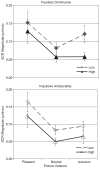Psychopathy, startle blink modulation, and electrodermal reactivity in twin men
- PMID: 16364071
- PMCID: PMC2242355
- DOI: 10.1111/j.1469-8986.2005.00353.x
Psychopathy, startle blink modulation, and electrodermal reactivity in twin men
Abstract
Psychopathy is a personality disorder with interpersonal-emotional and antisocial deviance facets. This study investigated these facets of psychopathy prospectively using normal-range personality traits in a community sample of young adult men who completed a picture-viewing task that included startle blink and skin conductance measures, like tasks used to study psychopathy in incarcerated men. Consistent with prior research, scores on the interpersonal-emotional facet of psychopathy ("fearless dominance") were associated with deficient fear-potentiated startle. Conversely, scores on the social deviance facet of psychopathy ("impulsive antisociality") were associated with smaller overall skin conductance magnitudes. Participants high in fearless dominance also exhibited deficient skin conductance magnitudes specifically to aversive pictures. Findings encourage further investigation of psychopathy and its etiology in community samples.
Figures
Similar articles
-
The startle paradigm in a forensic psychiatric setting: elucidating psychopathy.Crim Behav Ment Health. 2015 Feb;25(1):42-53. doi: 10.1002/cbm.1906. Epub 2014 Mar 24. Crim Behav Ment Health. 2015. PMID: 24664972
-
Clarifying the role of defensive reactivity deficits in psychopathy and antisocial personality using startle reflex methodology.J Abnorm Psychol. 2011 Feb;120(1):253-8. doi: 10.1037/a0021224. J Abnorm Psychol. 2011. PMID: 20973594 Free PMC article.
-
Startle reflex modulation, affective ratings and autonomic reactivity in incarcerated Spanish psychopaths.Psychophysiology. 2003 Nov;40(6):934-8. doi: 10.1111/1469-8986.00111. Psychophysiology. 2003. PMID: 14986846 Clinical Trial.
-
Emotion and psychopathy: startling new insights.Psychophysiology. 1994 Jul;31(4):319-30. doi: 10.1111/j.1469-8986.1994.tb02440.x. Psychophysiology. 1994. PMID: 10690912 Review.
-
Linking dimensional models of internalizing psychopathology to neurobiological systems: affect-modulated startle as an indicator of fear and distress disorders and affiliated traits.Psychol Bull. 2009 Nov;135(6):909-42. doi: 10.1037/a0017222. Psychol Bull. 2009. PMID: 19883142 Free PMC article. Review.
Cited by
-
Psychoneurometric operationalization of threat sensitivity: Relations with clinical symptom and physiological response criteria.Psychophysiology. 2016 Mar;53(3):393-405. doi: 10.1111/psyp.12512. Psychophysiology. 2016. PMID: 26877132 Free PMC article.
-
Emotional modulation of the pupil response in psychopathy.Personal Disord. 2019 Jul;10(4):365-375. doi: 10.1037/per0000313. Epub 2018 Dec 3. Personal Disord. 2019. PMID: 30507237 Free PMC article.
-
A Chimpanzee (Pan troglodytes) Model of Triarchic Psychopathy Constructs: Development and Initial Validation.Clin Psychol Sci. 2016 Jan 1;4(1):50-66. doi: 10.1177/2167702615568989. Epub 2015 Feb 17. Clin Psychol Sci. 2016. PMID: 26779396 Free PMC article.
-
Self-reported psychopathy in the Middle East: a cross-national comparison across Egypt, Saudi Arabia, and the United States.BMC Psychol. 2015 Oct 29;3:37. doi: 10.1186/s40359-015-0095-y. BMC Psychol. 2015. PMID: 26515052 Free PMC article.
-
As Far as the Eye Can See: Relationship between Psychopathic Traits and Pupil Response to Affective Stimuli.PLoS One. 2017 Jan 24;12(1):e0167436. doi: 10.1371/journal.pone.0167436. eCollection 2017. PLoS One. 2017. PMID: 28118366 Free PMC article.
References
-
- Benning SD, Patrick CJ, Hicks BM, Blonigen DM, Krueger RF. Factor structure of the Psychopathic Personality Inventory: Validity and implications for clinical assessment. Psychological Assessment. 2003;15:340–350. - PubMed
-
- Bradley MM, Codispoti M, Cuthbert BN, Lang PJ. Emotion and motivation I: Defensive and appetitive reaction in picture processing. Emotion. 2001;1:276–298. - PubMed
Publication types
MeSH terms
Grants and funding
LinkOut - more resources
Full Text Sources



